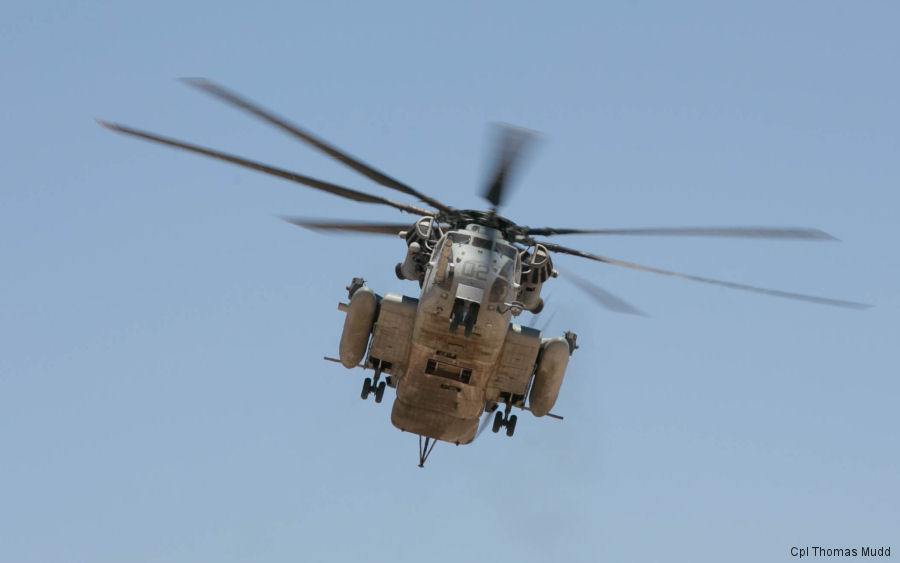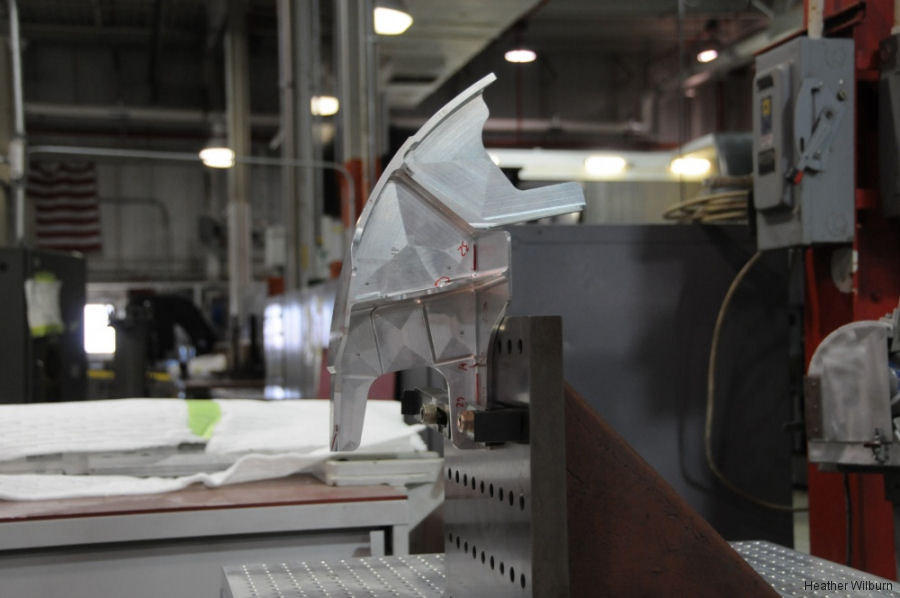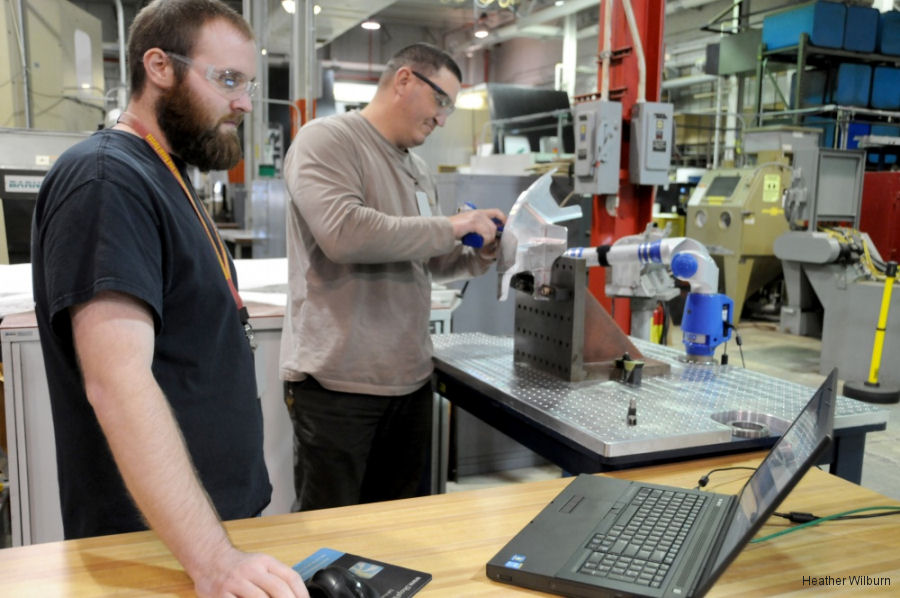
Manufacturing and material procurement issues prevented the helicopter’s original equipment manufacturer from producing the 522 fitting FRCE artisans needed to continue work on the aircraft, said David Rouse, an H-53 aircraft planner and estimator at the depot. The 522 fitting is vital to the function of the H-53 heavy lift helicopter; as one of the aircraft’s main structural supports, it carries the load for the helicopter’s tail and tail pylon – about 30 percent of its volume – during flight operations.
After several attempts to acquire the part through standard channels, the H-53 line turned to FRCE’s manufacturing branch for assistance – and the team came through. To date, they have completed one of the two fittings currently needed.
“These deficiencies would have driven the aircraft into long-term work stop, thus decreasing fleet readiness,” Rouse said. “To date, there has not been another manufacturer that has been successful in manufacturing the (fittings) within tolerances.
“The collaboration between FRCE’s Manufacturing and (Maintenance, Repair and Overhaul) Engineering branches continually provides resolutions to barriers, and workarounds when there are issues in the supply chain” he continued. “Their efforts here at FRCE have had a positive impact to H-53 readiness, and proves to the world that, in a time of need, FRCE and its teammates can make the impossible happen.”
Keith Linton, MRO Manufacturing branch head at FRCE, said his team often receives requests to manufacture parts. The request kicks off a process that involves a cross-disciplinary team of the depot’s artisans and engineers.
“The aircraft line will establish a need (for a) a fitting or a specialized part,” Linton explained. “If they can’t get it from Defense Logistics Agency or an outside source, they’ll contact our planning department and submit a request for us to manufacture the component. There are a number of steps in the manufacturing process, and with a critical safety item like this fitting, there are some additional measures to ensure the integrity of the part.”
Requests for parts
Requests for parts that are not otherwise in high demand or are unique often get routed to MRO Manufacturing, Linton said, because they aren’t financially viable as products for commercial suppliers. Once the MRO Manufacturing Planning Department receives the request from the aircraft line, they start the process of procuring the necessary material; once that material comes in, a lab verifies its composition and it is prepped for usage. At the same time, the team begins working with engineers to verify the part’s model or drawings.
“Then it goes to the programmers, who write the program to manufacture the part, which gets sent down to the machine – in this case, the five-axis milling machine – and we begin the process of manufacturing the part,” Linton said.
Writing the program involves the transfer of the part’s measurements and specifications from the drawings into a computer-aided manufacturing file that assigns a tool path to the milling machine, which cuts the component out of a solid block of material.
“The program could take two to three weeks, sometimes a month, depending on how complicated the file is,” Linton said. “This 522 fitting is a pretty complex part.”
Once the file is transferred to the milling machine, the project becomes the property of the machinist, who sees it through until the milling is complete. While some parts have been turned around in as little as 24 hours, the complex 522 fitting took about 100 hours of milling time. That can mean long hours and weekend work for the machinists, and the team at FRCE always rises to the challenge, Linton said.
“A lot of people don’t know how much work these guys put into the parts, and how much they can sacrifice to get these parts done, so we can get the aircraft back in the fight,” he said. “They’re a dedicated team that really takes to heart their mission of supporting the fleet.”
Once the machining process is complete, it’s time to measure the resulting product to ensure it meets the standard. The machinists measure the product, and Quality Assurance conducts a round of measurements, as well.
“With a (unique) part like this, we machine it and hope it measures up when we get done,” Linton said. “Basically, we’re proving it out, and doing a prototype on the first run. If the first part isn’t correct, we have to make another one. We’ll go back in and make adjustments, make changes to the program.
“When we assign the tool path, there’s nothing guaranteeing you the machine is going to do exactly what we want it to,” he continued. “There are so many factors – different compositions of the metal, different tools, speed and feeds – and all these things can affect how the part gets machined.”
It usually takes at least one prove-out to get the part machined within acceptable tolerances, Linton explained. When the part is approved, that program is then used to manufacture others.
The machining process is just the first step in manufacturing a finished product. Once the machinist’s job is complete, the part goes through a litany of other steps that can include cleaning, non-destructive inspection, plating, paint, labeling and more. The entire process can take up to 200 hours of work.
“This part started as a block of aluminum. When it’s complete, it will have been through a team of artisans that put their work into it,” Linton said. “It’s not just go make me a part. It’s really involved – there is a lot of effort that goes into something like this fitting.”
For machinist apprentice Collin Grummert, assisting with the manufacture of the 522 fitting provided a unique learning opportunity.
“It’s my first time working on a part this complex,” he said. ““I’ve learned the step-by-step what goes along with these parts, with making them: roughing it out, making it, checking it, working with Quality Assurance and the engineers. I had a chance to learn about everybody that’s involved, and what goes along with it.”
Grummert works alongside Chris McCoy, the model maker responsible for shepherding the 522 fittings through the machining process. McCoy said there’s a prestige involved in being tasked with machining parts that are on the critical safety item list, and he’s proud to be able to step up for the fleet.
“Every little detail has to be just right. You’ve got to be on point, because if one of these parts fail, an aircraft could fail – that’s somebody’s life in your hands,” McCoy said. “There’s a big sense of pride and accomplishment that goes along with it. There’s really a satisfaction to it.”
FRCE is North Carolina's largest maintenance, repair, overhaul and technical services provider, with more than 4,200 civilian, military and contract workers. Its annual revenue exceeds $835 million. The depot generates combat air power for America’s Marines and naval forces while serving as an integral part of the greater U.S. Navy; Naval Air Systems Command; and Commander, Fleet Readiness Centers.


See also |
MH/CH-53E in
FRCE
M/CH-53 Rotor Head Production at FRCE




